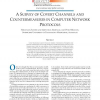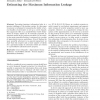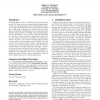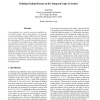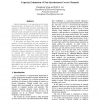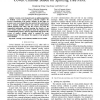116
click to vote
IEEEIA
2009
14 years 10 months ago
2009
Covert channel attacks utilize shared resources to indirectly transmit sensitive information to unauthorized parties. Current security mechanisms such as SELinux rely on tagging th...
TSE
2010
14 years 10 months ago
2010
Abstract—In multilevel systems it is important to avoid unwanted indirect information flow from higher levels to lower levels, namely the so called covert channels. Initial stud...
103
click to vote
IJNSEC
2007
15 years 5 days ago
2007
The exponential growth of the Internet (WWW in particular) has opened-up several avenues for covert channel communication. Steganographic communication is one such avenue. Hiding ...
COMSUR
2007
15 years 8 days ago
2007
Covert channels are used for the secret transfer of information. Encryption only protects communication from being decoded by unauthorised parties, whereas covert channels aim to ...
IJISEC
2008
15 years 8 days ago
2008
Preventing improper information leaks is a greatest challenge of the modern society. In this paper we present a technique for measuring the ability of several families of adversari...
106
click to vote
ENTCS
2006
15 years 8 days ago
2006
In multilevel systems it is important to avoid unwanted indirect information flow from higher levels to lower levels, namely the so called covert channels. Initial studnformation ...
117
click to vote
CCS
2006
ACM
15 years 4 months ago
2006
ACM
Location-hidden services, as offered by anonymity systems such as Tor, allow servers to be operated under a pseudonym. As Tor is an overlay network, servers hosting hidden service...
SP
1996
IEEE
15 years 4 months ago
1996
IEEE
Covert channels are a critical concern for multilevel secure (MLS) systems. Due to their subtlety, it is desirable to use formal methods to analyze MLS systems for the presence of...
ICDCSW
2005
IEEE
15 years 5 months ago
2005
IEEE
Capacity estimation is an important part of covert channel analysis. It measures the severity of a covert channel by estimating the maximum information rate attainable over it. Tr...
INFOCOM
2007
IEEE
15 years 6 months ago
2007
IEEE
—Known covert channel based on splitting algorithms in Medium Access Control (MAC) protocols requires the receiver’s knowledge of the sender’s identity. In this paper we pres...

